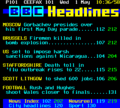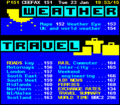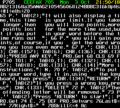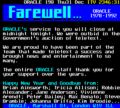Teletext offers one-directional data transmission, broadcast via television signal in the unused lines at the top of the image. Commonly it is found in analogue television signals and contains data for text and crude graphics. Digital televisions have text services which use a different method (almost HTML based). Teletext is also "Mode 7" on the BBC Micro.
Most commonly, Teletext decoders are built-in in (newer) television sets. Aside from that, there have been also Teletext interfaces for computers.
Teletext for CPC
- Teletext adaptor Teletext Adaptor (Microtext Ltd.)
- Volex TTX 2000a Teletext-Telesoftware Adaptor (Volex Electronics)
Telesoftware
Telesoftware was as service that allowed to download computer software, encoded in Teletext pages. Although no longer supported, Telesoftware recordings may be still found on old VHS Video Cassettes.
- CEEFAX - The British BBC CEEFAX supported Telesoftware from 1983 to 1989 (mainly for BBC computers). Apparently named because you can "see facts" which sounds like "Ceefax".
- ORACLE - The British Channel 4 ORACLE also supported Telesoftware (for different systems, including Amstrad. According to a Volex Advert, ORACLE also worked on broadcasting CP/M software).
Data Encoding
Teletext transfers 360 bits (45 bytes) per scanline; at a rate of 6.9375 Mbits/s (444 times the scanline rate). Transfer is restricted to a few scanlines (during VBlank period) so the effective transfer rate is less (and depends on the number of lines being used; which may vary from TV station to TV station).
Each byte includes a parity bit (so only 7bit per byte are actually containing usable data). The packets include some header/control bytes, and characters codes (using a variant of the standard ASCII character set).
Pictures
Here are few Teletext screenshots (not CPC screenshots, on CPC the font may have looked different, matching the standard 200 lines resolution).
Advertisements
Ad in Amstrad Computer User
Weblinks
- Teletext at the English-language Wikipedia
- Wikipedia: Telesoftware




